Legend of Dagmar von Medem
Note: This essay has been prepared and written by Jānis Stundiņš, news agency LETA, by reasons of personal interests of local history. He did the majority of the research in his own way, but worked with me to do some detective work, which is explained throughout the document. This article has been published in local Latvian papers and around the world in both English and Latvian.
The Truth About “Black Lady” in Eleja and Count’s Last Local Family
Both online and elsewhere is written about the lost Eleja palace [Schloß Elley], its inhabitants – Count von Medem family and kin – and the unusually fair and romantic ghost story about Eleja’s “black lady”, the apparition of Countess Dagmar von Medem’s unfortunate death and love. The existence of the ghost in the park of Eleja Manor is a question for the mystic world, but the subject of interest was the underlying life story of Dagmar von Medem. Such background for reality is unusual for ghost stories. Looking around for more information it came to the surprise that not only confirmed the veracity of this story, but it also allows for the first time to present the audience with Dagmar von Medem’s visual image, which has been incorporated into the image collage.
To uncover this history, I’m largely grateful to Rundāle Palace Museum’s Director Imants Lancmanis and Eleja’s palace von Medem family descendent Ned Tobin, who lives in Canada and does not carry the von Medem surname and title because he is as a successor to women’s line. His great-grandmother was Meta Adele von Medem – Dagmar’s sister. Ned is a photographer who is also dealing with painting, poetry and music, but in leisure he gathers their family tree and stores an archive.
Some recent Eleja resident of Count Paul von Medem family photos can be viewed at the website of Ned’s.
In order to facilitate this topic, I would like to briefly repeat the ghost story of Eleja’s Manor Park…
The owner of Eleja’s palace, Count Paul Heinrich, had a sixteen-year-daughter, Dagmar, who had fallen in love with a guy (gardener? policeman? stableman? soldier?), who was not among the nobility. The Count didn’t like this relationship. One day, when the young man was taken out with her father hunting, which Dagmar wanted to attend, but instead was not allowed and locked into the palace. She then jumped out the window. Naturally the father was grief stricken and he demanded to brick up the fatal window. Still to this day a girl’s ghost in a hunters black dress appears in Eleja park – either with a flashlight in the hands, or driving on horseback to bring the beloved.
The Real Story
Evidence of this story can still be found – in the cemetery of Sesava’s church people can still find a grave for Countess Dagmar von Medem, which, as shown in the engravings on a black granite tombstone, died at the age of sixteen (the inscription « Reichsgrafin Dagmar von Medem, geb.d.25 . Marz 1892 gest.d.16.September 1908 “). Similarly, on the end wall of the palace ruins remains a visibly bricked up window, which looks bricked up a long time ago – before the collapse of the palace. Likewise, the story of the Countess’ death “floats” from various sources and in different versions, but the baselines are not contradictory.
For easier understanding we’ll recall that the heroine of the legend of the ghost of Eleja’s Black Lady – sixteen year old Dagmar – was the daughter of Count Paul von Medem (Paul Peter Heinrich Theodor Graf von Medem) and his wife – Helen (who was born as Princess (fürstin) Helen von Lieven). They had a total of seven children – the original list of names (in brackets are the birth years):
– Helene (Ellen) Dorothy Jenny Mathilde von Medem (14 March 1888)
– Dina Meta Julie von Medem (2 February 1890)
– Dagmar Julie Elisabeth von Medem (25 March 1892)
– Meta Adele von Medem (25 September 1894)
– Friedrich (Fred) Nikolaus Johann Theodor von Medem (11 Jun 1897)
– Peter Paul Alexander von Medem (29 Jun 1898)
– Alexander Christoph Johann Conrad von Medem (August 16, 1902 ).
Dagmar’s sister Meta Adele later married the Baron Paul von Behr, in 1919 and have two daughters, Dagmar von Behr (Dagmar Dina Elisabeth Sybilla von Behr), which is Ned (full name Edward) Tobin’s grandmother, who at age 93 is still alive, and Marina von Behr who is 92 and still alive. Meta died in Canada in 1984.
In consultation with Dagmar’s niece in Canada, and Mr. Lancmanis in Rundāle, it is found – perhaps without the addition of a ghost – the memory of the tragedy of young Medem is the same, and it turns out the only detail in question is the bricked up window.
Lancmanis wrote to me: “The credibility of Dagmar’s tragic legend is no doubt true. I have questioned the Baroness Gerharda von Hoiningen-Huene, a daughter of Dagmar’s brother Fred von Medem, and Count Paul Medem granddaughter, who knew all the circumstances of her aunts, sisters, and Dagmar. I met her in 1987, when her contemporaries were still alive. Dagmar, in a photograph belonging to this Medem’s granddaughter, see the third floor of the back room with semi-circular window that the event was not bricked up and ruin seen in the 20s of the 20th century. “
Detail of the bricked up windows are becoming doubtful and closely observed by Lancmanis, who in 1992 compiled a catalog “Palace of Eleja”, where the photographs and testimonies of contemporaries summarizes research on the placements of the palace. As shown by chronicle of rebuilding the palace the final bricked up window in the wall, which is now seen in ruins, was bricked up during the indoor rebuilding long before the birth of Dagmar, and behind the bricked up window there were the count’s – the father’s – apartments, while the children were in the rooms of the palace on the second floor (above the ground floor and first floor), where Dagmar would have been. So, according to legend, Dagmar jumped not from a first, but from a second-floor window what makes the tragic outcome even more reliable.
Detecting faces
Among Ned’s archival photographs my attention was attracted by a picture showing all seven children of Paul von Medem’s (see attached image gallery). Asked by Ned, his grandmother Dagmar von Behr recognized the children in such order (children’s picture – from left to right): Dina, Peter, Dagmar, Meta, and Helen (Ellen), who holds Alexander on her lap and seated on the floor in front of is small Friedrich.
However, matching the age of the children caused Ned’s and my doubts as to whether the grandmother’s 93 years will not be confused. Judging by the fact that Alexander is one and a half to two years old, when this photograph was created, probably it was taken in 1904, when Dagmar was still twelve.
Then Ned recently received from relatives unique and amazing photographs – among them the portrait, which bears the inscription, which shows that it is a portrait of Dagmar (see attached image gallery). Compared to the faces of young children on the picture, it became clear that Dagmar is sitting on the right – that’s with their newest little brother on her lap. Ned, aligning it with relative’s data, concluded that Paul’s children overall picture are in the following order (from left): Dina, Peter, Helen (Ellen), Meta, Dagmar with Alexander in her lap and Fred Friedrich on the floor in front.
With Dagmar’s portrait known from these new photographs, it is suspected that her pretty face might be in another photograph where she’s depicted on horseback, as well as in striped blouse between the sisters at the table – it is unfortunate that the faces are blurred. For these photos (see attached image gallery) Ned does not feel it is certain, and it is only at the level of suspicion to identify Dagmar as such.
What was the last Medem at Eleja’s palace
Ned does not have a lot of stories about Paul and Helen Medem’s family while they stayed at Eleja’s palace, but there are some memories that have been recounted from the local people around Eleja. These memories were collected 20 years ago by Eleja’s manor house manager, the late Janis Skulte. He used to visit the local elders in Eleja, recording their memories of their parents’ and grandparents’ lives at the manor, among whom many storytellers then were already so old that today they are dead (lucky that I’ve copied and saved few records of J.Skulte). Of course, these memories are covered by a “veil of approximate”.
From the stories of these elders, the Count was a cool, arrogant, and rigid man in his relations with the peasants and servants, but he was also fair and did not avoid communication with peasants. During Paul’s reign in Eleja there was a kind of economic boom, thanks to the brewery and distillery. From the memories of von Medem descendants in the catalog “Palace of Eleja”, alcohol, despite its production, had almost no use in the palace. During rare evening parties there were served champagne and red wine, and in very rare cases, men were given a dram of vodka. The beer was not used in the palace because it was considered improper and the only place for beer must be pub, of which the Count was a rare visitor to, by other stories.
From the memories of the elders in Eleja, the family of the Count and the villagers celebrated together Latvian’s traditional midsummer festival “Līgo”, harvest festival and Christmas. The midsummer festival and harvest festival occurred outside the palace in the park area, while Christmas was celebrated in the palace. The park of the manor had been a very luxurious and exotic place, but later, after the World War I, year after the year it lost this luxury. The Count had been very natty and the same he demanded from the people.
The Count dealt with horse breeding, they were particular horses. During the harvesting the working horses were changed every two hours. After the harvest, the harvesters did not meet with the Count himself, but he arranged tables rich with food and barrels of beer for everybody to eat and drink how much they wanted.
One very old lady remembered the story about her father. In 1887 her father helped to stop horses gone wild, which became wild carrying the coupe with ladies of Count’s family, while gentlemen were riding alone. After this rescue the father’s leg was broken, and the Count ordered to take her father to the hospital in Jelgava and to take care of him until he will be absolutely healed. Later her father, who also was able to read, worked for four years as general manager of the forge servicing the Count’s horses.
Lancmanis said that “even the Count’s granddaughter (Gerharda von Hoiningen-Huene) said that he was a very proud and arrogant gentleman, who always retained a distance with everybody. This does not exclude the fact that he could have a good enough relationship with the surrounding peasants and farmers”.
Among the images, Ned also had a photo of two ladies in luxurious costumes of that time (see attached image gallery). Here, though, it should be noted that the costumes are typical early 20th century – Art Nouveau era. During those times in a similar style there were dressed also relatively wealthier or more sophisticated Latvian ladies, such as poetesses Aspazija or Zemgaliešu Biruta.
In this photograph the two ladies were recognized by Lancmanis: “Both are sisters – Count’s Paul von Medem’s wife Helen, who is sitting, and Dina (Alexandrine) von Lieven, who is standing. Both were daughters of Prince Alexander von Lieven, the landlord of Bukaiši. Dina was married three times – twice with Barons von Hahn, then with Baron von Hoiningen-Huene.”
The reality behind the legend of Dagmar
Looking at Dagmar’s photo, strange feelings obsess about the ghost story, because it is difficult to imagine such a teenage ghost. Anyway, unbelievable seem those ghost story versions which mention tall black woman (grown up). And if someone sees a woman, not a girl, maybe it is not Dagmar? And maybe it’s not a ghost at all?
I do not intend here to analyze mysticism or the spiritual world, because it has its own role to play – especially in human emotions, fantasy, art, and in the world of love. The possible real story looks quite logical – a sixteen year old teenager who fell in love, which her father doesn’t accept that. It was not the first time that a noble or aristocratic family had a teenager that rebelled.
The phantom in the park, from all the ghost stories seems to have this gentle or sane ending: “But still in the bright present times of ours and in the fragrant nights of full moon Dagmar may ride beside you on galloping black horse while her hunting coat streaming in the wind. Don’t stop her, wish her luck, because she hurries to reach hunters with her beloved. Dagmar will calm down only when she will overtake them.”
It seems this is a legend about a ghost obsessed with love, but also weak and tender. It is not a horrible ghost story, that is for sure. It creates a wish to leave and not disturb this ghost and let it fly.
But if any lovers are thinking about this legend and wishing a significant or symbolic moment, is there another way to remember Dagmar’s death in love and longing? It was not suicide and not murder, it was only death that separated lovers. Maybe it’s not worth to look for her ghost in the autumn nights? Instead, may it be better to remind her (and all of us) the faith for love, by putting some flowers on the Dagmar’s grave?
Jānis Stundiņš, news agency LETA, by personal interests of local history
Local Newspaper Clippings of the Death of Dagmar von Medem
Found in the newspaper were the following articles. The first was published and then the following day the second was published acknowledging a mistake made in the first publishing. These have been found and scanned by Jānis Stundiņš.
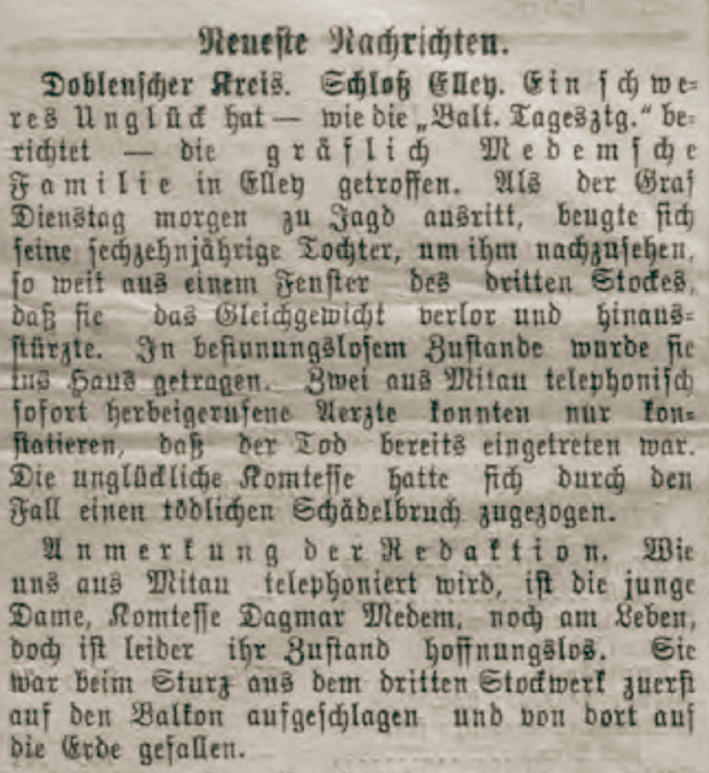
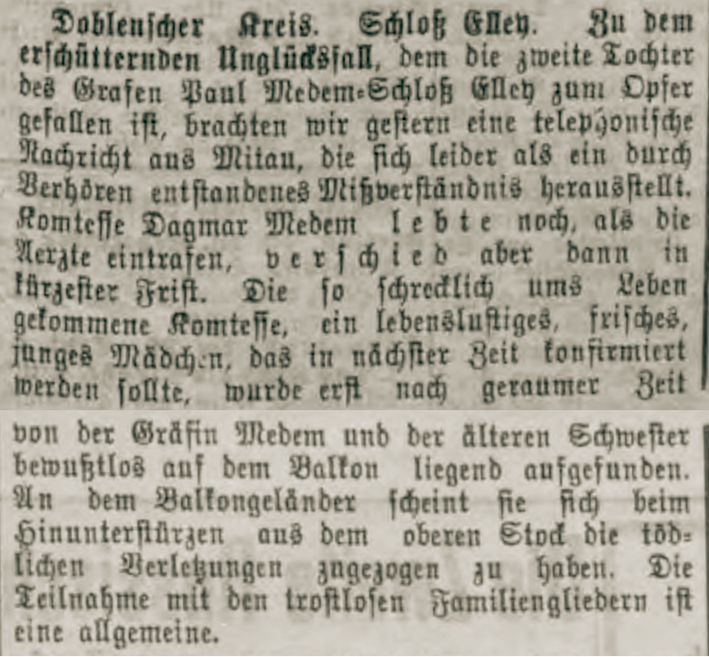
Thanks in full to Aigars Bokalders who has been so kind to translate the above newspaper articles as follows:
Rigasche Zeitung 217 (first day)
Dobele’s county. Elley’s palace. As the “Baltische Tageszeitung” reports, a serious accident has hit the Count Medem family in Elley. As the Count went hunting Tuesday morning, his sixteen-year-old daughter bent over to look at him, so far out of a third-floor window that she lost her balance and fell out. She was carried into the house in an unconscious state. Two doctors immediately summoned from Mitau (Jelgava) by telephone could only determine that the death had already occurred. The unfortunate Countess had suffered a fatal fracture of the skull as a result of the fall.
Editor’s note: As we are told on the phone from Mitau (Jelgava), the young lady, the Countess Dagmar Medem, is still alive, but unfortunately her condition is hopeless. She had first hit the balcony when she fell from the third floor and therefrom fell to the ground.
Rigasche Zeitung 218 (second day)
Dobele’s county. Elley’s palace. In addition to the shocking accident to which the second daughter of Count Paul Medem in the Elley’s palace fell victim, we brought a telephone message from Mitau (Jelgava) yesterday, which unfortunately turns out to be a misunderstanding caused by mishearing. The Countess Dagmar Medem was still alive when the doctors arrived, but then passed away shortly after. The Countess, who lost her life in so terrible way, was a life loving, fresh, young girl who was to be confirmed soon. The Countess, lying unconscious on the balcony, was found by the Countess Medem and the older sister after quite some time. On the balcony railing, she appears to have suffered the fatal injuries when she fell from the upper floor. We all share this grief with the desolated family members.



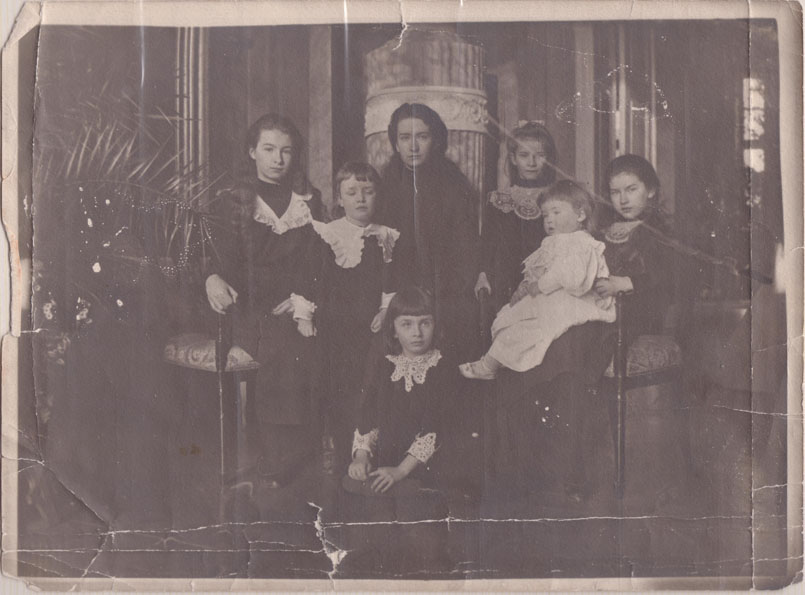
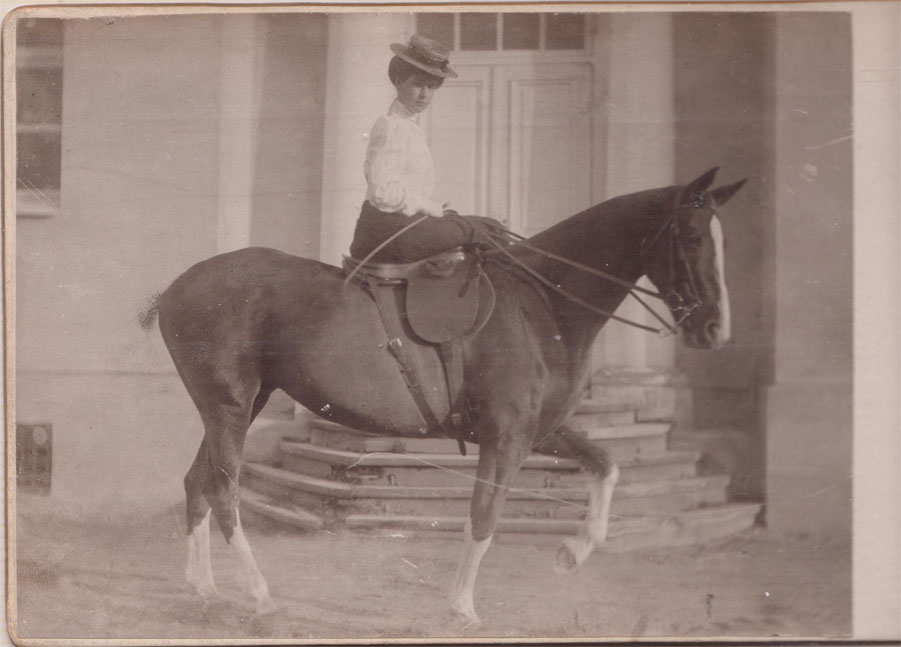

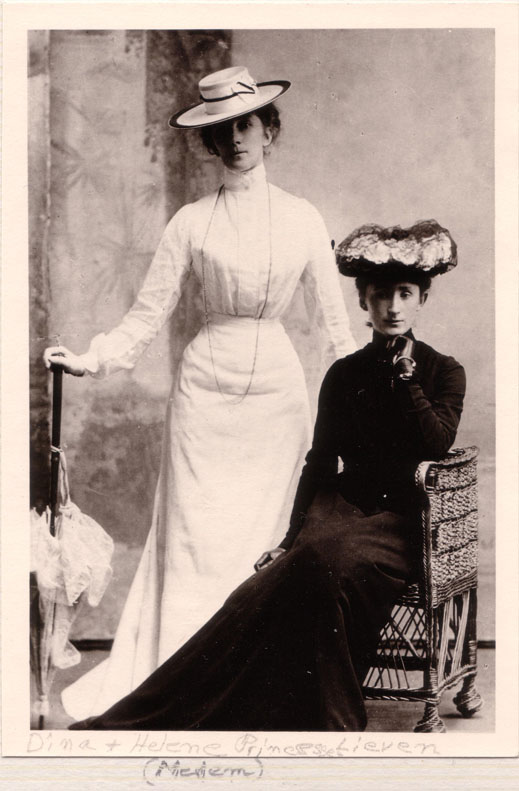
Hallo, Im Jahre 2011 kam ich während einer Rundreise mit meinem Campingbus auch zu einer Kirche in der Nähe des Schlosse Pilsrundäle. Auf dem ehemaligen Friedhof bemerkte ich die Grabplatte von Dagmar von Medem und habe ein Foto davon gemacht. Ich habe mich gefragt, warum sie so jung gestorben ist. Nach langen privaten Unannehmlichkeiten hatte ich erst jetzt Zeit, im Internet zu recherchieren. Was für eine Geschichte! Das Schicksal von Dagmar hat mich sehr berührt.
Nur eines verstehe ich nicht, warum wird das Grab nicht hergerichtet? Man könnte es auch als touristisches Ziel angeben. Schließlich steckt eine alte Legende dahinter und die Menschen lieben solche Geschichten. Jetzt nach der Öffnung der Grenzen dürfte es kein Problem sein, Dagmar wieder ein schönes Grab herzurichten. Vielen Dank und mit freundlichen Grüßen
Hallo Erik, Es ist wirklich faszinierend, mich auch! Danke zu sagen so, und gute Reise!
Ned
I have discovered your web site with interest, I have been searching for Prince Paul von medem who married Helene Jentsch. I wonder if you have a family tree that would help. Unfortunately there are no dates on my family tree that was put together in the 1920’s. Could he be Paul von Medem born 1800 who inherited Eleja Palace and past it on to his brother Peter. There are family rumours that he had a morganatic marriage and could be why his brother Peter inherited..
I would be grateful for any help you can give me and happy to share information.